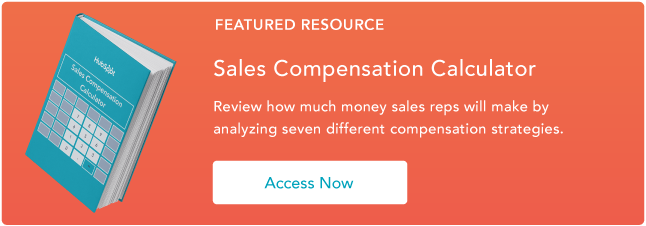Incentive compensation plans often provide an effective avenue for sales leadership to motivate their teams and encourage overperformance. Meaningful incentives influence behavior in any context, and sales is no exception.
Without incentive compensation, reps might be less inclined to exceed or even meet quota routinely. By extending some sort of performance-based financial reward, you can provide some extra oomph to encourage your reps to stay on top of their sales efforts — well beyond the bare minimum.
There are several brands of incentive compensation. Let's take a look at a few potential methods you can leverage to get more out of your sales team.
Incentive Compensation Examples
1. Gainsharing Plan
A gainsharing plan is an incentive compensation model where an organization incentivizes employees to overperform by offering financial shares of the business gains that stem directly from their improved individual performance.
2. Retention Bonus
A retention bonus is a financial bonus a company offers an employee — typically calculated as a percentage of that employee's base pay — for staying with the business for a predetermined period.
3. Profit-Sharing
Profit-sharing is similar to gainsharing in that it offers employees incentive payments based on a company's financial gains. The difference is that gainsharing rewards salespeople for their individual performance whereas profit-sharing rewards employees for a company's overall profitability.
4. Spot Awards
Spot awards are generally small incentives — either financial or non-monetary — offered to recognize individual employees for exceptional short-term performance.
5. Annual Incentives
The term "annual incentive" typically refers to a one-time, lump-sum payment made on top of a salesperson's normal compensation for a fiscal year based on how they performed within that time frame.

Long-Term Incentive Compensation
While most incentive compensation plans are generally employed on a short-term basis, there are some plans that companies leverage to incentivize loyalty and overperformance over more extended periods.
Incentives like restricted stock-based packages and cash bonuses — awarded to employees after reaching certain long-term goals or staying on at the company for specified time frames — are examples of long-term incentive compensation.
Now that you have a picture of what an incentive compensation plan might look like, let's see how you can go about putting one of your own together.
Incentive Compensation Plans
1. Planning
Any effective incentive compensation plan starts with considerable thought and extensive planning — winging it won't cut it here. You need to start structuring yours a few months out (at least) and create a definitive, predictable framework that your reps can understand and reliably work within. Getting there involves addressing a few key elements.
Aligning With Organizational Goals
Before you can start piecing your incentive compensation plan together, you need a solid grip on what you hope to accomplish with it. Consider your company's broader quantitative organizational goals. Are there specific numbers you're looking to hit?
Your plan is going to be guided, in large part, by those figures. They're central to setting realistic, effective quotas for reps — and incentive compensation plans often revolve primarily around reps attaining or exceeding quota.
Once you have this side of the plan drilled down, you can start to take a closer look at how you can most effectively motivate your reps to deliver on those objectives.
Determining How You'll Motivate Your Team
Different kinds of reps are going to be receptive to different kinds of incentives. A program that suits a team of account executives might not align with one that can most effectively accommodate a crop of SDRs.
For instance, lower-level reps might be interested in a performance-based competition for who can schedule the most demos whereas more seasoned reps might be more motivated by a program that offers a financial incentive for exceeding annual quota.
No matter what framework you elect to go with, make sure your plan is appropriately tailored to align with your team's interests and individual priorities.
2. Continuous Reporting
Structuring an effective incentive compensation plan is an ongoing process. That's why constant reporting is crucial to refining your program and keeping it running as smoothly as possible. You need to keep key stakeholders in the loop and have a pulse on how your sales org is performing if you want to get the most out of your plan.
Reports that let reps keep tabs on their performance relative to quota, track high-level organizational performance, capture manager evaluations, and give hard pictures of how effective your plan is all need to be accounted for when implementing an incentive compensation plan.
All told, you need consistent visibility into the ins and outs of your program. That starts with you identifying the most relevant metrics and reports — and continues with you tracking them intently.
3. Clear Communication
Your reps can't operate within your incentive compensation plan framework if they don't understand it. So if you want to see the results you're looking for, you need to thoroughly explain what's expected of them and what they can expect to receive if they perform to the standards you set.
Let your team know your organizational goals and how the compensation plan will play into them. Listen to any concerns they might raise. Your goals have to be realistic and reasonably attainable. If most of your team takes a look at your objectives and tells you that they don't think they'll be able to meet them — even with incentives — you might want to reevaluate your strategy.
4. Evaluation
Let's say you run your incentive compensation plan for a quarter. Once that window is up, you're going to need to determine whether the program was effective and worth repeating. That's where conducting comprehensive evaluations comes in — from both higher-level and ground-floor perspectives.
Take a close look at the key metrics you landed on for gauging the success of your program. Did you reach your goals on an organizational level? How did the figures you hit stack up against the ones you projected?
And how did your team fare personally within the confines of the plan? Did the program put too much strain on morale? Make sure you consider the impact of your incentive compensation plan holistically — considering both the program's broader efficacy and impact on employee wellbeing.
You'll also want to factor in elements beyond your sales org's control. Changing economic tides and shifting market circumstances will play pivotal roles in shaping your organizational goals and, in turn, how you structure your incentive compensation plan.
5. Calculated Improvements and Optimization
As I mentioned, putting together an effective incentive compensation plan is an ongoing process. There is almost always room for improvement as yours progresses. That's why optimizing your program is much more of a "need-to-do'' than a "nice-to-do."
Consistently collect feedback from any stakeholders involved in the process — from reps to management. That will help you identify gaps in your program like issues stemming from outdated tech or lack of direction from leadership.
From there, you can start to update and refine your plan at allotted intervals — usually on a quarterly, semiannual, or annual basis. Using the insight you've accrued through your evaluation, you can modify your plan to suit stakeholders' needs and adapt to changing circumstances beyond your sales org.
These changes can include upgrading your tech stack, developing a more structured governance model, adjusting goals, accommodating changes in company strategy, or building around product launches.
Incentive Compensation Management Software
1. QuotaPath
Pricing: Free Plans Available — Paid Plans Starting at $288 per Year
.webp?width=624&height=427&name=emailmarketing_2%20(6).webp)
QuotaPath provides a centralized, accessible platform that covers all of the bases needed to structure and implement a productive incentive compensation plan — along with a range of other compensation-based applications.
The platform directly integrates with your CRM, allowing you to easily keep tabs on earnings and closed deals — providing you with a complete, responsive basis for your incentive compensation program.
Best for Versatility
QuotaPath is a dynamic incentive compensation solution that allows for a range of plans — and that kind of versatility is what really sets it apart from its competition. The platform offers the resources to structure self-guided and collective incentive compensation plans.
Its tracking, gamification, and team goal setting features can both create an air of incentive-driven competition and encourage teams to earn incentives together. If you want a first-rate solution that can reliably support virtually any kind of incentive compensation plan, look into QuotaPath.
2. CaptivateIQ
Pricing: Available Upon Request

CaptivateIQ is one of the preeminent incentive compensation management solutions on the market. It takes the legwork out of implementing and sustaining an effective incentive compensation plan through its powerful automation capabilities. And its seamless data sharing features affords both leadership and reps insight into team and individual performance.
Best for Ease of Use
CaptivateIQ really sets itself apart from its competition with its accessibility and ease of use. It has a straightforward interface that reconciles simplicity with powerful functionality. If you're interested in an effective incentive compensation management program that everyone in your organization can easily pick up, consider going with CaptivateIQ.
3. Xactly Incent
Pricing: Available Upon Request

Xactly Intent is a solid incentive compensation management program. It boasts impressive payout time-saving figures — routinely cutting compensation administration time by up to 60%. The solution also has a bank of 15 years worth of pay and performance data to draw from for guiding effective plan design.
Best for Constant Accessibility
Xactly Intent's main differentiator is in its consistent accessibility for leadership and reps alike. The program is mobile-friendly and available on-demand — offering sales teams clear views into their results and potential earnings wherever, whenever. If you need an incentive compensation management solution that your team can readily access on a dime, check out Xactly Intent.
4. Spiff
Pricing: Available Upon Request

Spiff boasts an impressive customer base — including big names like Qualys, Qualtrics XM, and Lucid — and for good reason. The program provides real-time commissioning, personalized dashboards for individual team members, and adaptability when it comes to adjusting commissions and bonuses.
Best for Scalability
The solution's customer base isn't limited to the heavy hitters listed above — it suits smaller businesses just as well as large enterprises. And that's where the program's strength lies: scalability. If you're looking for an incentive compensation management software that can easily grow with you as your business expands, look into Spiff.
5. Anaplan
Pricing: Available Upon Request

Anaplan provides an effective, sophisticated solution for businesses looking to model functional incentive compensation plans. The program offers refined modeling, real-time signals, and robust collaboration capabilities to help companies structure plans that deliver results.
Best for Scenario Modeling
While it boasts an impressive suite of other features, Anaplan distinguishes itself through its scenario modeling features. It allows sales teams to create unlimited "what-if" scenarios to help businesses reliably evaluate adjustments — providing insight into how changes will impact a plan's potential success.
6. Everstage
Pricing: Available Upon Request

Everstage offers a no-code commission automation solution that suits virtually any kind of customer-facing team — from SDRs to CSMs. Created by a team of RevOps professionals, the software is tailored to streamline the incentive commission plan structuring process with features like real-time data aggregation and in-platform exception requests and approvals
Best for an Extensive Suite of Integrations
One key element that Everstage nails particularly well is its suite of integrations. The program syncs with several other programs, including HubSpot, Salesforce, Pipedrive, and Intuit Quickbooks. If you're looking for a powerful incentive compensation solution that lines up with your existing tech stack, check out Everstage.
7. ElevateHQ
Pricing: Available Upon Request
ElevateHQ offers both no-code and low-code workspace to automate any plan under the sun. It has all the table stakes, bells, and whistles that you’d expect from a market leader without any additional costs and confusion.
Best for Quick Implementation and Established ROI
Elevate recently bagged the “Fastest Implementation” and “Best Established RoI” badges in G2.com’s Spring 2023 reports. That’s because ElevateHQ offers an extended implementation team at no additional cost. This team automates the most complex of plans within 28 days and is available to customers over Slack whenever they hit a wall.
See results with a well-structured incentive compensation plan.
The soundness of your incentive compensation plan could be the difference between fostering overperformance across your sales team and having your reps plateau or get complacent.
If you elect to leverage one of these kinds of plans, make sure it lines up with both your organizational goals and your team's bandwidth. If you can address both of those elements effectively, you can put together a plan that will pay off in spades.
Sales Compensation
.png?width=112&height=112&name=Image%20Hackathon%20%E2%80%93%20Vertical%20(82).png)
.jpg)





